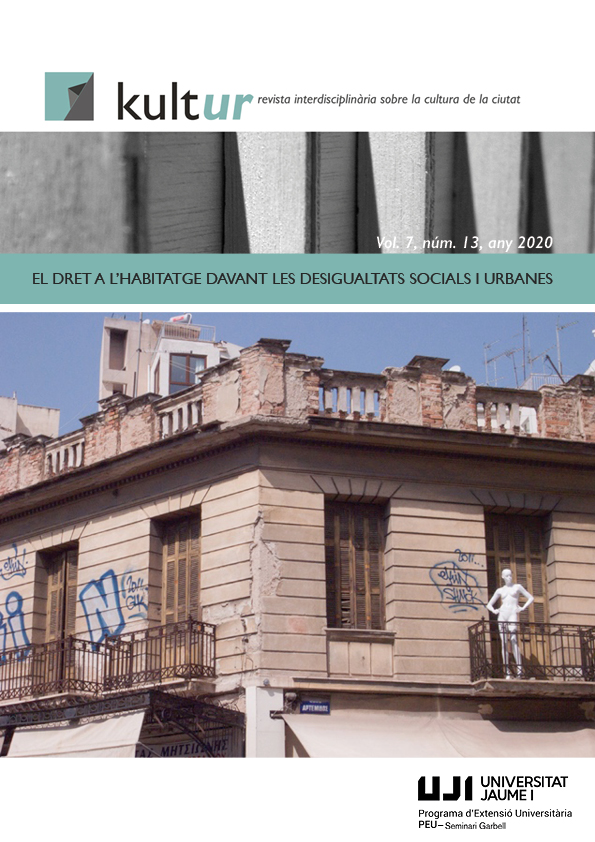Cities and geodiversity: coexistence of humans and abiotic nature in urban territories
##plugins.themes.bootstrap3.article.main##
Resum
Urbanization is an irreversible global process. Natural elements and systems present in city territories or at non-city sites attend to the demands for natural assets from urbanization processes. Renewed attention to the impacts of the urban organization of societies is essential to promote the harmonious survival of urbanization with natural processes. Although the presence of humans on the planet represents just a small fraction of the Earth’s history, human agglomeration in cities has caused impacts on a global scale. Cities demand services and products from natural areas that are sometimes located in faraway rural areas, affecting geological environments such as beaches, rivers and aquifers, and other processes such as hydrological cycles or atmospheric circulation. The anthropogenic impact on urban catchment areas may induce unexpected environmental degradation in urban areas that affects the hydrological cycle. Although relative newcomers in terms of the Earth’s lifetime, cities are a privileged human habitat, with intrinsic maintenance mechanisms that form the basis of the modern organization of the world’s societies and economies. The present article adopts a geological perspective and a land ethic paradigm to discuss alternatives for a harmonious existence between cities and abiotic nature.
Descàrregues
##plugins.themes.bootstrap3.article.details##
.png)
Tots els continguts de la revista kult-ur se distribueixen sota una llicència d'ús i distribució Creative Commons Atribució-Compartir Igual 4.0 Internacional (CC BY-SA 4.0), excepte indicació contrària. Pot consultar ací la versió informativa i el text legal de la llicència. La indicació de la llicència d'ús i distribució CC BY-SA 4.0 ha de constar expresament d'aquesta manera quan siga necessari.
Referències
Brilha, J. (2016). Inventory and quantitative assessment of geosites and geodiversity sites: A review. Geoheritage, 8(2), 119-134. doi:10.1007/s12371-014-0139-3
Cevasco, R., Moreno, D., & Hearn, R. (2015). Biodiversification as an historical process: An appeal for the application of historical ecology to bio-cultural diversity research. Biodiversity and Conservation, 24(13), 3167-3183. doi:10.1007/s10531-015-0943-3
Flores Urushima, A. (2015). Territorial prospective visions for Japan’s high growth: The role of local urban development. Nature and Culture, 10(1), 12-35.
Gordon, J. E., Barron, H. F., Hansom, J. D., & Thomas, M. F. (2012). Engaging with geodiversity—why it matters. Proceedings of the Geologists’ Association, 123(1), 1-6. doi:10.1016/j.pgeola.2011.08.002
Gray, M. (2017). Geodiversity: The backbone of geoheritage and geoconservation. In: Reynard, E. & Brilha, J.: Geoheritage – Assessment, Protection and Mangement. Elsevier doi:10.1016/B978-0-12-809531-7.00001-0
Haines-Young, R. & Potschin, M. (2013) CICES v4.3 – Revised report prepared following consultation on CICES Version 4, August – December 2012. EEA Framework Contract No EEA/IEA/09/003.
Ilić, M. M., Stojković, S., Rundić, L., Ćalić, J., & Sandić, D. (2016). Application of the geodiversity index for the assessment of geodiversity in urban areas: An example of the Belgrade city area, Serbia. Geologia Croatica, 69(3), 325-336. doi:10.4154/gc.2016.27
IPCC (2014) Climate Change 2014: Synthesis Report. Contribution of Working Groups I, II and III to the Fifth Assessment Report of the Intergovernmental Panel on Climate Change. Core Writing Team, R.K. Pachauri and L.A. Meyer (eds.). IPCC, Geneva, Switzerland, 151 pp.
Larwood, J. G., Badman, T., & McKeever, P. J. (2013). The progress and future of geoconservation at a global level. Proceedings of the Geologists Association, 124(4), 720-730. doi:10.1016/j.pgeola.2013.04.001
Lefèbvre, H. (1970). La révolution urbaine. Paris: Gallimard
Leopold, A. (1970) A Sand County Almanac, With Essays on Conservation from Round River. Ballantine Books. New York - USA.
Martin, l.; Suguio, K.; Flexor, J-M; Dominguez, J.M.L. and Bittencourt, A.C.S.P. (1987) Quaternary evolution of the central part of the Brazilian coast. The role of relative sea-level variation and of a shoreline drift. In: Quaternary Coastal Geology of West Africa and South America, UNESCO Report in Marine Science, 43, 97-145.
Pereira, R. F., Brilha, J. & Martinez, J. E. (2008) Proposta de enquadramento da geoconservação na legislação ambiental brasileira. Memórias e Notícias- Revista Cient. do Dept. de Ciências da Terra e do Museu Mineralógico e Geológico da Universidade de Coimbra. No.- 3 (Nova Série). Coimbra-PT, p- 491- 499. Available at: http://sigep.cprm.gov.br/destaques/Pereira_Brilha_Martinez_GDCL_2008.pdf, downloaded at June 24th, 2019.
Pereira, R. F. (2010) Geoconservação e desenvolvimento sustentável na Chapada Diamantina (Bahia – Brasil). Tese de doutoramento, Escola de Ciências da Universidade do Minho (Braga/Potugal). 295 p. Available at: http://hdl.handle.net/1822/10879, downloaded at June 24th, 2019.
Portal, C., & Kerguillec, R. (2018). The shape of a city: Geomorphological landscapes, abiotic urban environment, and geoheritage in the western world: The example of parks and gardens. Geoheritage, 10(1), 67-78. doi:10.1007/s12371-017-0220-9
Sharples, C. (2002) Concepts and Principles of Geoconservation. Published electronically on the Tasmanian Parks & Wildlife Service website (Version 3). Available at: http://dpipwe.tas.gov.au/Documents/geoconservation.pdf, downloaded at June 24th, 2019.
Sivakumar, B. (2011). Water crisis: From conflict to cooperation-an overview. Hydrological Sciences Journal, 56(4), 531-552. doi:10.1080/02626667.2011.580747
United Nations Department of Economic and Social Affairs UNDESA (2012) World Urbanization Prospects: The 2011 Revision. New York: United Nations.


